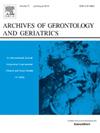揭示血浆中肌肉减少症的蛋白质代谢物网络:一项大规模孟德尔随机研究
IF 3.5
3区 医学
Q2 GERIATRICS & GERONTOLOGY
引用次数: 0
摘要
背景:一些血浆分子可能对肌肉减少症有影响,但尚未完全了解。我们旨在全面探索血浆蛋白和代谢物对肌肉减少症性状的因果关系,并揭示其网络。方法采用双样本孟德尔随机化设计。来自35559名冰岛人的4907种血浆蛋白水平和来自8299名欧洲人的1400种血浆代谢物水平被设定为暴露。低握力、阑尾瘦质量和欧洲人的正常步行速度作为研究结果。采用反方差加权(IVW)和其他四种方法,以及敏感性分析来估计因果关系。富集分析和途径分析表明了它们的特征。IVW用于估计肌少症相关蛋白和代谢物之间的双向关系,并在网络中可视化它们。结果鉴定出76种蛋白质与肌肉减少症性状之间的关系。因果效应的绝对值(βIVW)在0.01 ~ 0.35之间。IL2、AIF1、GDNF、CXCL13、LRRTM3和SLPI是因果关系排名前六的蛋白。此外,鉴定了代谢产物与肌肉减少症性状之间的22种关系,βIVW的绝对值在0.02 ~ 0.22之间。硫酸盐和丝氨酸/丙酮酸比值最高。网络图显示了ISOC1、GSTA1、色氨酸和5α-雄甾烷-3α,17β-单硫酸二醇等关键节点。结论首次揭示了肌少症在血浆中的分子网络,并鉴定了一些关键蛋白和代谢物。这可能有助于了解肌少症的发病机制,为肌少症的预测、诊断和治疗提供新的见解。本文章由计算机程序翻译,如有差异,请以英文原文为准。
Unraveling the protein-metabolite network of sarcopenia in plasma: A large-scale Mendelian randomization study
Background
Some plasma molecules may have an effect on sarcopenia, but it is not fully understood. We aimed to comprehensively explore the causal effects of plasma proteins and metabolites on sarcopenia traits, and to unravel their network.
Methods
A two-sample Mendelian randomization design was adopted. The levels of 4,907 plasma proteins from 35,559 Icelanders, and 1,400 plasma metabolites from 8,299 Europeans, were set as exposures. Low handgrip strength, appendicular lean mass, and usual walking pace from Europeans were set as outcomes. Inverse-variance weighted (IVW) and four other methods, along with sensitivity analyzes, were performed to estimate the causal effects. Enrichment and pathway analyzes were conducted to present their characteristics. IVW was used to estimate the bidirectional relationships between sarcopenia-related proteins and metabolites, and to visualize them within a network.
Results
We identified 76 relationships between proteins and sarcopenia traits. The absolute values of causal effects (βIVW) ranging from 0.01 to 0.35. IL2, AIF1, GDNF, CXCL13, LRRTM3, and SLPI were the top six proteins ranked by causal effects. Additionally, 22 relationships between metabolites and sarcopenia traits were identified, with absolute values of βIVW ranging from 0.02 to 0.22. Sulfate and serine/pyruvate ratio had the highest values. The network diagram showed some key nodes, such as ISOC1, GSTA1, tryptophan and 5α-androstan-3α,17β-diol monosulfate.
Conclusions
This work unraveled a molecular network of sarcopenia in plasma for the first time and identified some key proteins and metabolites. It may help to understand the mechanisms of sarcopenia, providing new insights for predicting, diagnosing and treating sarcopenia.
求助全文
通过发布文献求助,成功后即可免费获取论文全文。
去求助
来源期刊
CiteScore
7.30
自引率
5.00%
发文量
198
审稿时长
16 days
期刊介绍:
Archives of Gerontology and Geriatrics provides a medium for the publication of papers from the fields of experimental gerontology and clinical and social geriatrics. The principal aim of the journal is to facilitate the exchange of information between specialists in these three fields of gerontological research. Experimental papers dealing with the basic mechanisms of aging at molecular, cellular, tissue or organ levels will be published.
Clinical papers will be accepted if they provide sufficiently new information or are of fundamental importance for the knowledge of human aging. Purely descriptive clinical papers will be accepted only if the results permit further interpretation. Papers dealing with anti-aging pharmacological preparations in humans are welcome. Papers on the social aspects of geriatrics will be accepted if they are of general interest regarding the epidemiology of aging and the efficiency and working methods of the social organizations for the health care of the elderly.

 求助内容:
求助内容: 应助结果提醒方式:
应助结果提醒方式:


